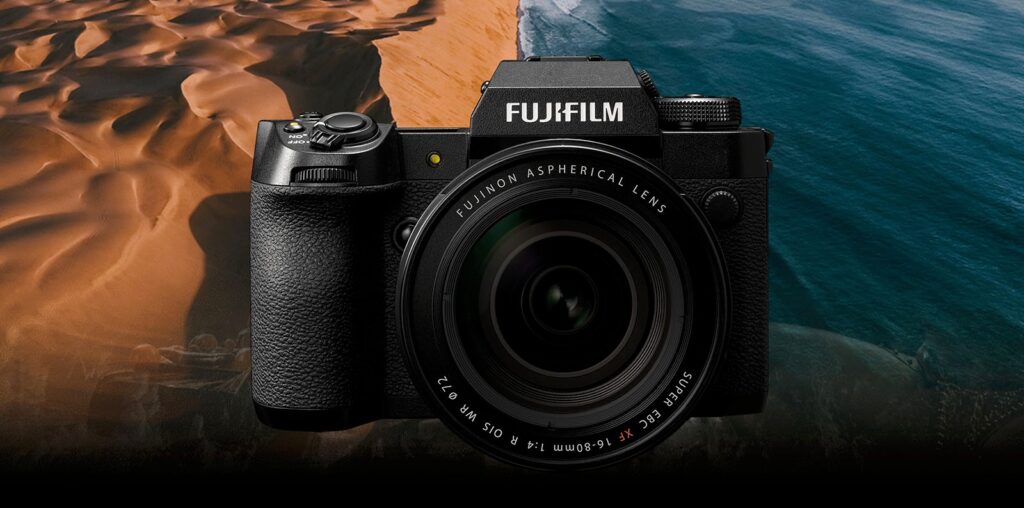![]()
In an interview with French publication Phototrend, Franck Bernard, the director of the imaging division of Fujifilm France, shared a lot of interesting information about Fujifilm’s market performance, latest cameras, and whether the company might make a new film camera in response to enthusiasm around analog photography.
In a machine-translated version of the interview conducted at the recent Salon de la Photo show in Paris, France, Bernard said that Fujifilm is the market leader in the camera market that does not include full-frame cameras, possessing “around 40% market share.”
This is worth exploring a bit. While Fujifilm is a major player in the APS-C space with its X Series cameras, the company’s GFX medium-format system also comprises part of this 40%. Basically, of all Micro Four Thirds, APS-C, and medium-format digital cameras, plus some other niche offerings with other sensor sizes, Fujifilm has a significant piece of the total pie.
And it’s not like other companies aren’t part of this space. There are some popular APS-C cameras on the market, for example, including Sony’s a6700 and ZV-E10 series cameras, the Nikon Zfc and Z50, and Canon EOS R7 and R10, to name just a few. For Fujifilm to have such a stranglehold on the non-full-frame market is impressive.
The company has had a strong 2024 so far, too. The X100VI still, many months after its release, experiences excessive demand, while the new GFX 100S II is one of the best value propositions on the market for photographers who demand the utmost in image quality.
Speaking of the X100VI’s massive demand, which has made the camera nearly impossible to purchase without a long wait time, Bernard says the company was very aggressive in its production before announcing the camera, but the demand proved “unimaginable.”
“People are waiting for it, and I apologize for the unavailability of the product. But I think we’ll manage to deliver all the boxes ordered in just 10 to 11 months,” he adds. Fingers crossed, photographers will, at some point, be able to buy the X100VI easily.
There’s also the brand-new Fujifilm X-M5, an affordable X Series camera aimed at users seeking their first camera.
But don’t call the X-M5 an “entry-level camera,” Bernard warns. While the X-M5’s $800 price point is aggressive in today’s market, that’s still a healthy chunk of change. “You have to be careful with your words,” Bernard quips, acknowledging that the X-M5’s relatively low price point significantly expands Fujifilm’s offerings for different budgets.
“We realized that there was a real demand in this price segment, especially among young people. The smartphone is a springboard to this type of case, both in terms of price and audience,” he says.
The X-M5 is also an exciting addition to Fujifilm’s lineup for another reason, as it’s the first camera to sport Fujifilm’s new, more environmentally-friendly packaging. Bernard notes the company’s aggressive CO2 reduction plans. As part of this initiative, Fujifilm looked at how to reduce the environmental impact of its packaging, including eschewing the colorful inks that make cardboard harder to recycle, the amount of plastic in the package, and the often-unnecessary chargers and cables that most customers already have. Fujifilm tells PetaPixel the X-M5’s new packaging approach will carry over to all the company’s future cameras.
Speaking of future cameras, Fujifilm has carved out its healthy market share thanks in significant part to its incredible Film Simulations, which meticulously recreate the look of popular film stocks from Fujifilm’s past (and, in some cases, its present). When Fujifilm’s X Series launched more than a decade ago, film photography was struggling, so this digital facsimile approach made a lot of sense and scratched a nostalgic itch.
![]()
Increasing numbers of photographers are scratching that itch by buying actual film cameras. Film is experiencing an enormous resurgence, and some companies are even making brand-new film cameras, including Pentax and Mint. Will Fujifilm leverage its rich analog history by making a new film camera?
In a disappointing blow to analog enthusiasts, Bernard says no.
“For now, I don’t think a new film camera is on the agenda,” he says. However, he stops short of shutting that door entirely. “I prefer to remain cautious,” Bernard adds.
Franck Bernard discussed many other topics with Phototrend, including artificial intelligence, how Fujifilm shrunk its new XF 16-55mm f/2.8 Mark II lens by so much, Fujifilm’s utility for sports and photojournalism, and much more. The complete interview is available on Phototrend.
Image credits: Fujifilm

